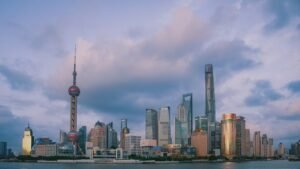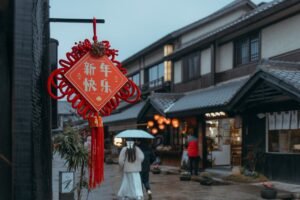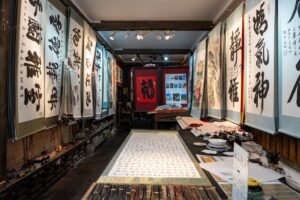The transformation of Chinese society over the centuries has been complex, deeply influenced by history, politics, and culture. Literature, especially novels, offers a unique window into these societal changes, serving both as a reflection and a catalyst for shifts in social norms and values. Chinese novels have evolved alongside society, providing a narrative thread that connects the past to the present and offering insights into the dreams, struggles, and lives of Chinese people across different eras. This article explores how Chinese society has transformed through literature, focusing on key historical periods, the role of political changes, and the impact of contemporary narratives.
Table of Contents
Toggle1. Classical Chinese Novels and Reflections of Social Hierarchy
Classical Chinese literature provides a profound understanding of the societal structures and values of ancient China. These works often reflect the rigid social hierarchies and moral expectations that characterized traditional Chinese society. For centuries, literature served as both entertainment and a tool for imparting Confucian, Daoist, and Buddhist values. Through novels, writers could subtly critique social norms while reinforcing values such as loyalty, filial piety, and virtue.
One of the most iconic examples is Journey to the West (《西游记》 Xī Yóu Jì), written by Wu Cheng’en (吴承恩 Wú Chéng’ēn) during the Ming Dynasty. This novel tells the story of the Buddhist monk Xuanzang (玄奘 Xuánzàng) and his disciples, including the mischievous Monkey King, Sun Wukong (孙悟空 Sūn Wùkōng). Although it is widely known as a tale of adventure and spiritual enlightenment, the narrative also serves as a critique of Ming society’s rigid bureaucracy and social hierarchies. The journey represents the struggles of self-cultivation and the pursuit of moral perfection, concepts deeply rooted in Confucianism and Buddhism. The characters embody various facets of human nature and spiritual struggles, making the novel a rich source of philosophical reflection.
Similarly, Dream of the Red Chamber (《红楼梦》 Hóng Lóu Mèng) by Cao Xueqin (曹雪芹 Cáo Xuěqín), written during the Qing Dynasty, offers an intricate portrayal of life within a wealthy aristocratic family. The novel explores the social structures and gender norms of its time, focusing on the decline of the Jia family. This decline symbolizes the vulnerability of traditional values as the Qing Dynasty faced economic and political challenges. Through its detailed character development and complex narrative, Dream of the Red Chamber reveals the tensions between individual desires and societal expectations, making it a timeless study of human emotion and social decay.
2. Modern Chinese Literature and the May Fourth Movement
The early 20th century was a period of tremendous change in China, marked by the fall of the Qing Dynasty and the establishment of the Republic of China (中华民国 Zhōnghuá Mínguó). This era saw the rise of the May Fourth Movement in 1919, a cultural and political movement led by students and intellectuals who advocated for modernization, intellectual freedom, and a rejection of traditional Confucian values. The movement had a profound influence on Chinese literature, giving birth to a generation of writers who used their works to critique the old social order and push for reform.
Lu Xun (鲁迅 Lǔ Xùn), often considered the father of modern Chinese literature, became a central figure during this time. His short story Diary of a Madman (《狂人日记》 Kuángrén Rìjì) is one of the first works to employ modern narrative techniques and psychological analysis. The story’s protagonist, who becomes convinced that those around him are engaged in cannibalism, symbolizes Lu Xun’s critique of traditional Chinese society, which he perceived as oppressive and dehumanizing. The metaphor of “eating people” (吃人 chī rén) served as a powerful commentary on the moral decay inherent in the old feudal system. Lu Xun’s work was a clarion call for societal and cultural renewal, inspiring subsequent writers to challenge established norms.
Other writers like Ba Jin (巴金 Bā Jīn) and Lao She (老舍 Lǎo Shě) also contributed to the modernization of Chinese literature during this era. Ba Jin’s Family (《家》 Jiā) explores the generational conflict between the younger, reform-minded members of a traditional family and their conservative elders. This narrative mirrors the broader societal push for modernization and the rejection of outdated customs. Lao She’s Rickshaw Boy (《骆驼祥子》 Luòtuo Xiángzi) depicts the life of a Beijing rickshaw puller, capturing the struggles of the urban poor during the early Republican era. These novels collectively portrayed a China in flux, where the conflict between tradition and modernity played out in the lives of everyday people.
3. Revolutionary Literature and Socialist Realism
With the establishment of the People’s Republic of China in 1949, literature took on a new role under the Communist government. Mao Zedong emphasized the importance of literature as a means of promoting socialist ideals and revolutionary values. This period, known as the era of socialist realism, saw a shift in the themes and purposes of Chinese novels, which now focused on class struggle, the heroism of the working class, and loyalty to the Communist Party.
One of the notable works from this period is Red Crag (《红岩》 Hóng Yán) by Luo Guangbin (罗广斌 Luó Guǎngbīn) and Yang Yiyan (杨益言 Yáng Yìyán), which depicts the heroism of Communist soldiers during the struggle against the Kuomintang (KMT) forces. These works aimed to inspire loyalty and promote the values of collectivism and sacrifice. While they served as effective tools for political education, they often lacked the complexity and emotional nuance of earlier literary traditions.
The Cultural Revolution (文化大革命 Wénhuà Dà Gémìng) from 1966 to 1976 brought even more severe restrictions on literary expression. Intellectuals and writers were targeted, and many literary works were banned for not aligning with Party ideology. The period’s emphasis on political purity led to a reduction in the diversity of literary themes, as traditional culture was denounced as feudal and counter-revolutionary. As a result, literature during this time became narrowly focused on glorifying Mao Zedong’s thought and the successes of the Cultural Revolution.
4. The Emergence of Scar Literature and a New Era of Expression
The end of the Cultural Revolution and the onset of economic reforms in the late 1970s marked a turning point in Chinese literature. A new wave known as “scar literature” (伤痕文学 Shānghén Wénxué) emerged, with writers using their works to express the trauma and suffering experienced during the Cultural Revolution. These stories often dealt with themes of loss, disillusionment, and the search for personal meaning in the aftermath of ideological fervor.
Zhang Xianliang’s (张贤亮 Zhāng Xiánliáng) Half of Man is Woman (《男人的一半是女人》 Nánrén de Yībàn Shì Nǚrén) is a prominent example of this genre. The novel portrays the hardships of life under the harsh political environment of the Cultural Revolution and explores themes of identity and human dignity. Similarly, Wang Meng’s (王蒙 Wáng Méng) The Butterfly (《蝴蝶》 Húdié) provides a critical examination of the psychological scars left by the Cultural Revolution, blending realism with introspective narrative techniques.
This period also saw a shift from collective ideology to individual experience, reflecting the broader changes occurring in Chinese society as it moved towards economic modernization. Literature became a space where writers could explore deeper emotional and psychological themes, offering a more nuanced perspective on the human condition.
5. Contemporary Chinese Novels and Globalization
With China’s economic reforms and integration into the global economy in the 1980s, Chinese literature entered a new era. Contemporary novels began to address the complexities of a rapidly modernizing society, focusing on issues such as urbanization, globalization, and the clash between tradition and modernity.
Mo Yan (莫言 Mò Yán), who won the Nobel Prize in Literature in 2012, is a key figure in this era. His novel Red Sorghum (《红高粱》 Hóng Gāoliáng) blends magical realism with a vivid portrayal of rural life in Shandong Province (山东省 Shāndōng Shěng), set against the backdrop of the Japanese occupation. The novel explores themes of family, resilience, and tradition, offering both a celebration of Chinese folklore and a critique of the social and political realities of rural China. Mo Yan’s work reflects the tension between local traditions and the broader forces of modernity.
Another significant contemporary writer, Yu Hua (余华 Yú Huá), addresses the theme of survival amidst societal change in his novel To Live (《活着》 Huózhe). The story follows a man named Fugui, who endures personal loss and hardship through various tumultuous periods in modern Chinese history, including the Cultural Revolution and the Great Leap Forward. To Live paints a vivid picture of the resilience of ordinary people in the face of historical upheaval, offering a more human-centered perspective that contrasts with the collective narratives of earlier socialist realism.
6. Literature as a Lens for Understanding Globalization and Identity
As China has become increasingly integrated into the global community, Chinese literature has also adapted to address themes of globalization, migration, and cultural identity. Writers like Ha Jin (哈金 Hā Jīn) and Ma Jian (马建 Mǎ Jiàn), who write both in Chinese and English, explore the complexities of Chinese identity in a globalized world. Ha Jin’s novel Waiting (《等待》 Děngdài) explores themes of love, loyalty, and the tension between personal desires and societal expectations during the Cultural Revolution. Ma Jian’s Beijing Coma (《北京植物人》 Běijīng Zhíwùrén) offers a critical examination of the Tiananmen Square protests and their aftermath, providing a powerful reflection on the struggle for personal freedom in an authoritarian state.
The rise of internet literature (网络文学 wǎngluò wénxué) has further expanded the reach of Chinese storytelling. Online platforms have allowed new writers to reach millions of readers, offering stories that engage with contemporary issues like economic disparity, youth culture, and the challenges of modern relationships. This digital transformation has given voice to a new generation of Chinese writers, making literature more accessible and diverse.
Conclusion: The Power of Chinese Novels in Shaping Society
From the classical tales that shaped traditional values to the modern narratives that address contemporary challenges, Chinese novels have always played a vital role in reflecting and shaping the evolution of Chinese society. They serve as a bridge between past and present, offering insights into China’s history, culture, and the aspirations of its people. For those looking to deepen their understanding of these literary treasures and gain a broader perspective on Chinese society, learning the language is an essential step. At LC Chinese School in Oslo, we offer a range of Chinese language courses that immerse students in the rich cultural contexts from which these novels emerge. Join us to explore the depths of Chinese literature and understand the complex history it reveals. Register for our classes today at https://lcchineseschool.com/no/flexible-classes-2/.








